Abstract
Serum and urine from 100 subjects of a general population highly exposed to airborne hexachlorobenzene (HCB) were analyzed to obtain new insights into the metabolism of this ubiquitous compound. HCB was detected in all serum samples with concentrations ranging between 1.1 and 953 ng/ml. The major known metabolites of HCB were investigated in urine collected over 24 hr. Pentachlorophenol (PCP) was detected in all urines with values ranging between 0.58 and 13.9 micrograms excreted in 24 hr [mean +/- standard deviation (SD), 2.52 +/- 2.05; geometric mean, 2.05]. A sulfur derivative that, after hydrolysis, yielded pentachlorobenzenethiol (PCBT) could also be identified and quantified in all the urines with values ranging between 0.18 and 84.0 micrograms of PCBT excreted in 24 hr (mean +/- SD, 3.47 +/- 10.8; geometric mean, 1.39). The sulfur derivative assessed as PCBT appeared to be the main metabolite, with urinary concentrations surpassing those of PCP in the subjects with higher HCB accumulation (HCB in serum > 32 ng/ml). PCBT concentration in urine collected over 24 hr showed a very strong association with HCB concentration in serum; the association was stronger in males than in females. An increase of 1 ng/ml of HCB in serum led to an increase of 2.12 micrograms of PCBT excreted in urine collected over 24 hr in males (95% CI, 1.82-2.44) and to an increase of 0.67 microgram of PCBT in females (CI, 0.33-1.09). A weaker association was found between PCP in urine and HCB in serum, which was only statistically significant in males (an increase of 1 ng/ml of HCB in serum led to an increase of 0.63 microgram of PCP excreted in urine collected over 24 hr; (CI, 0.34-0.95). These results show that the formation of the cysteine conjugate is a quantitatively more important metabolic pathway in humans than the formation of PCP. Moreover, the association found suggests that PCBT is a good urinary marker of HCB internal dose and glutathione-mediated metabolism.
Full text
PDF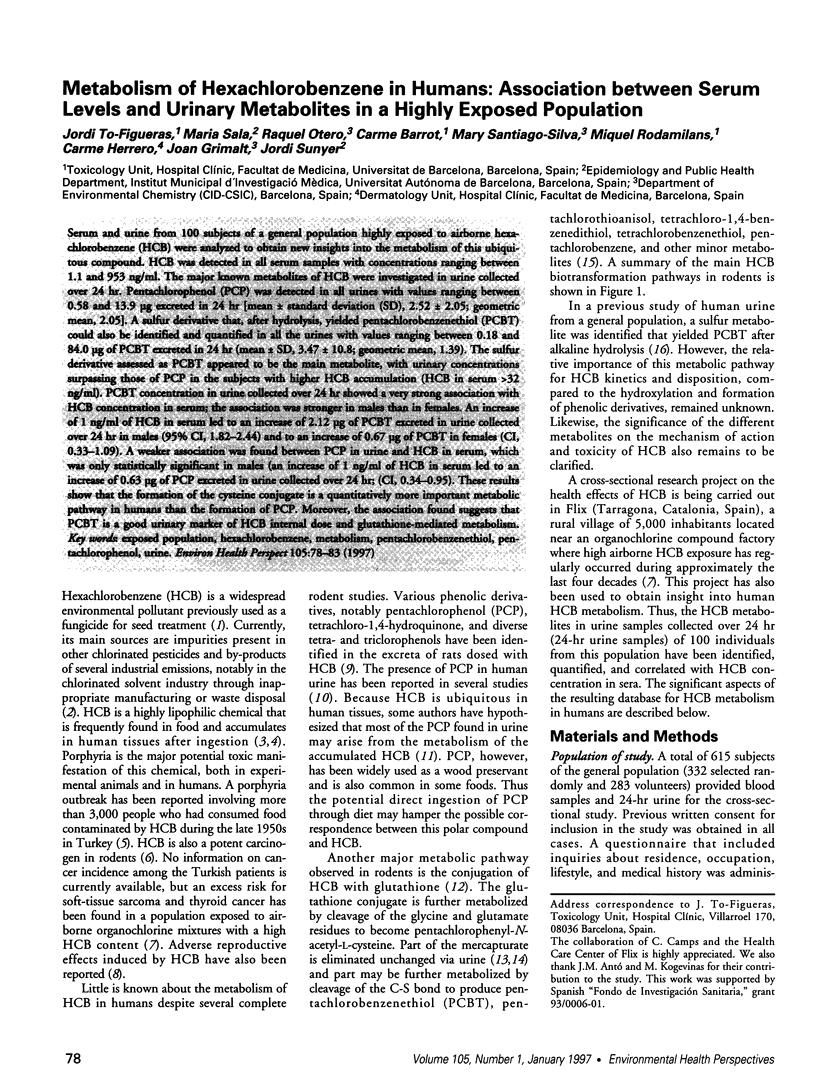
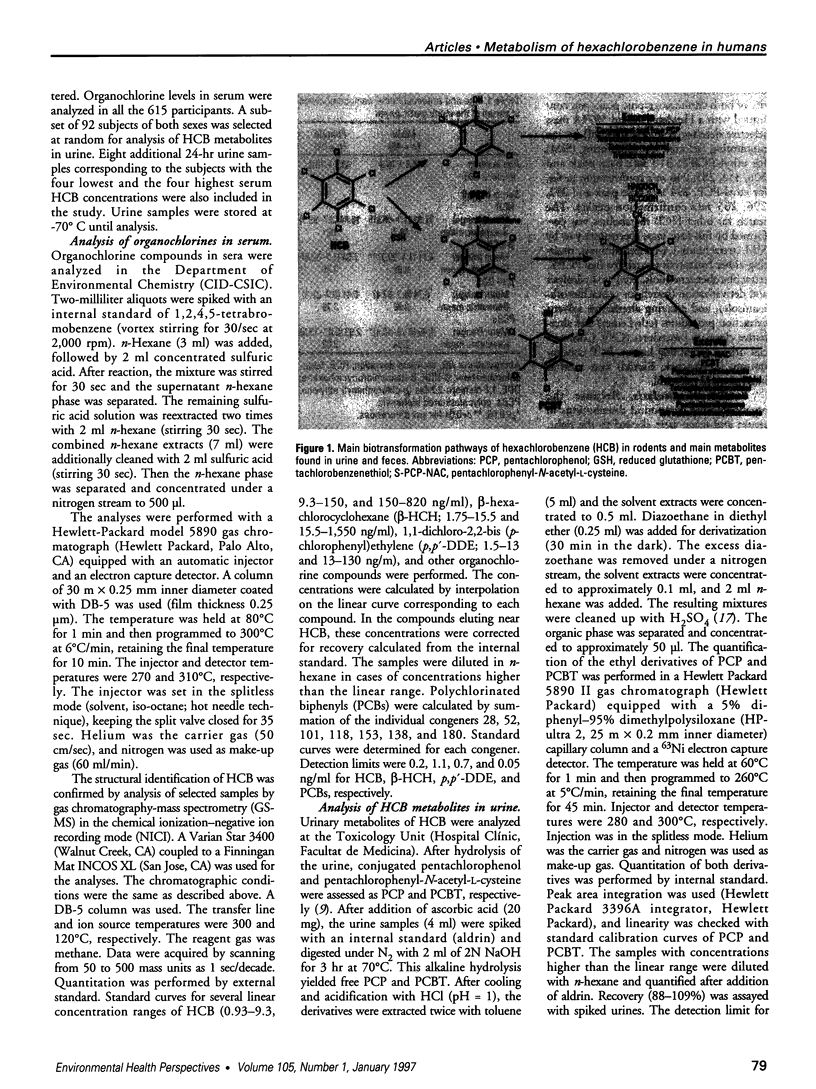

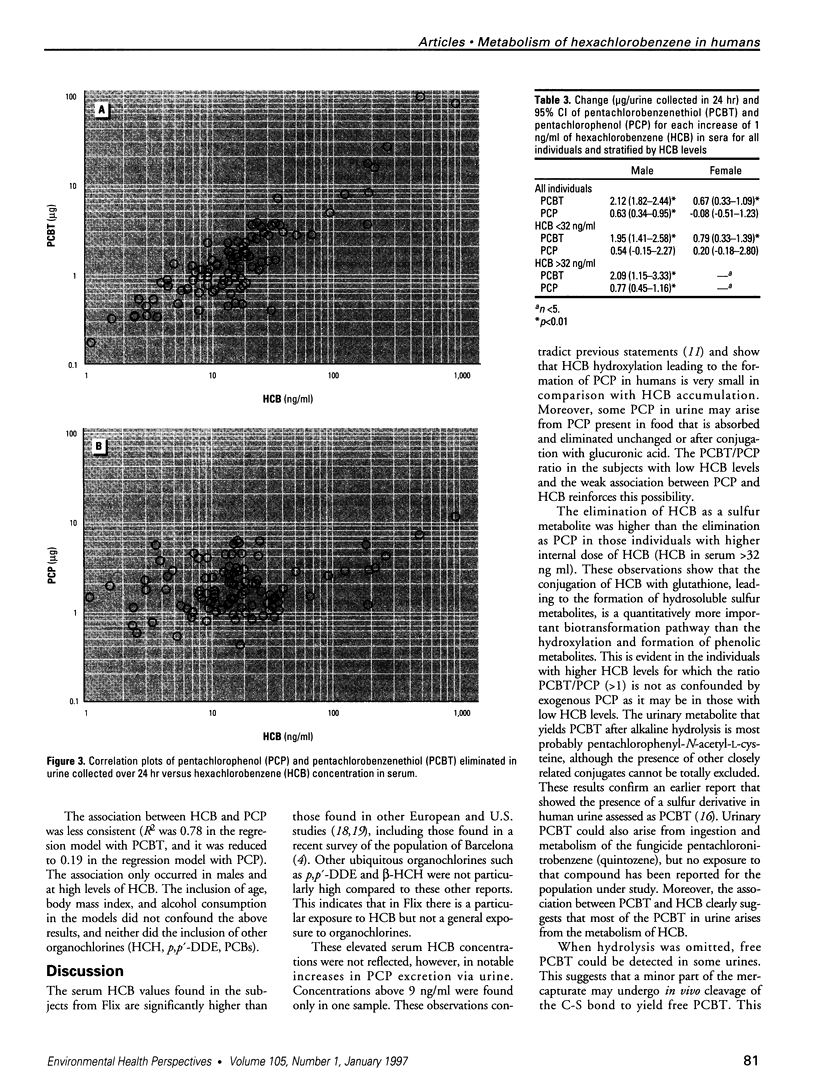
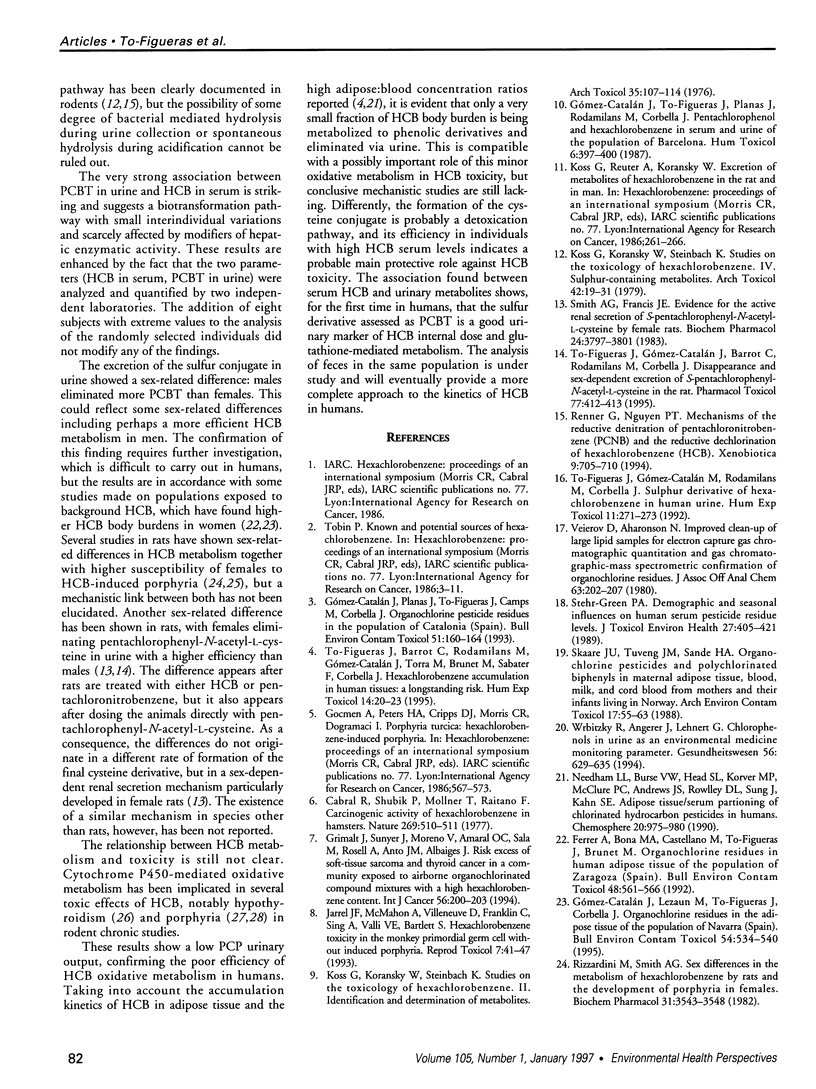
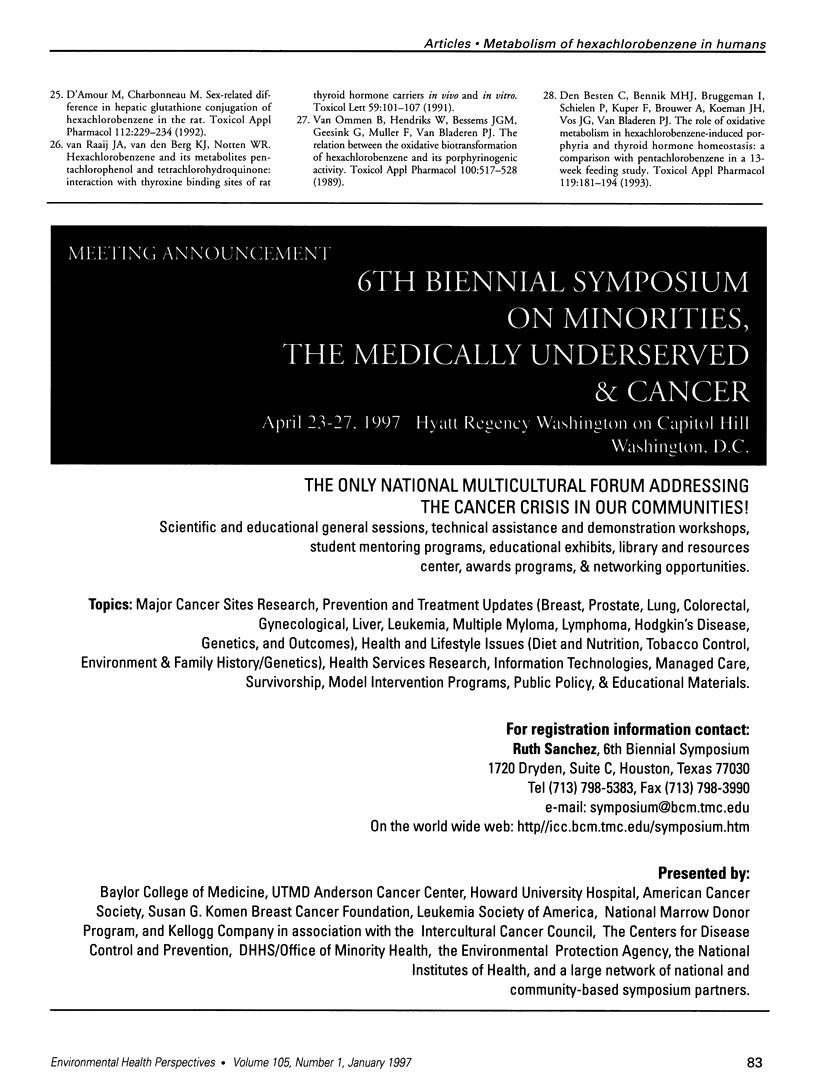
Images in this article
Selected References
These references are in PubMed. This may not be the complete list of references from this article.
- Cabral J. R., Shubik P., Mollner T., Raitano F. Carcinogenic activity of hexacholorobenzene in hamsters. Nature. 1977 Oct 6;269(5628):510–511. doi: 10.1038/269510a0. [DOI] [PubMed] [Google Scholar]
- D'Amour M., Charbonneau M. Sex-related difference in hepatic glutathione conjugation of hexachlorobenzene in the rat. Toxicol Appl Pharmacol. 1992 Feb;112(2):229–234. doi: 10.1016/0041-008x(92)90192-u. [DOI] [PubMed] [Google Scholar]
- Ferrer A., Bona M. A., Castellano M., To-Figueras J., Brunet M. Organochlorine residues in human adipose tissue of the population of Zaragoza (Spain). Bull Environ Contam Toxicol. 1992 Apr;48(4):561–566. doi: 10.1007/BF00199074. [DOI] [PubMed] [Google Scholar]
- Grimalt J. O., Sunyer J., Moreno V., Amaral O. C., Sala M., Rosell A., Anto J. M., Albaiges J. Risk excess of soft-tissue sarcoma and thyroid cancer in a community exposed to airborne organochlorinated compound mixtures with a high hexachlorobenzene content. Int J Cancer. 1994 Jan 15;56(2):200–203. doi: 10.1002/ijc.2910560209. [DOI] [PubMed] [Google Scholar]
- Gómez-Catalán J., Lezaun M., To-Figueras J., Corbella J. Organochlorine residues in the adipose tissue of the population of Navarra (Spain). Bull Environ Contam Toxicol. 1995 Apr;54(4):534–540. doi: 10.1007/BF00192596. [DOI] [PubMed] [Google Scholar]
- Gómez-Catalán J., Planas J., To-Figueras J., Camps M., Corbella J. Organochlorine pesticide residues in the population of Catalonia (Spain). Bull Environ Contam Toxicol. 1993 Jul;51(1):160–164. doi: 10.1007/BF00201015. [DOI] [PubMed] [Google Scholar]
- Gómez-Catalán J., To-Figueras J., Planas J., Rodamilans M., Corbella J. Pentachlorophenol and hexachlorobenzene in serum and urine of the population of Barcelona. Hum Toxicol. 1987 Sep;6(5):397–400. doi: 10.1177/096032718700600509. [DOI] [PubMed] [Google Scholar]
- Jarrell J. F., McMahon A., Villeneuve D., Franklin C., Singh A., Valli V. E., Bartlett S. Hexachlorobenzene toxicity in the monkey primordial germ cell without induced porphyria. Reprod Toxicol. 1993;7(1):41–47. doi: 10.1016/0890-6238(93)90008-u. [DOI] [PubMed] [Google Scholar]
- Koss G., Koransky W., Steinbach K. Studies on the toxicology of hexachlorobenzene. II. Identification and determination of metabolites. Arch Toxicol. 1976 Mar 11;35(2):107–114. doi: 10.1007/BF00372764. [DOI] [PubMed] [Google Scholar]
- Koss G., Koransky W., Steinbach K. Studies on the toxicology of hexachlorobenzene. IV. Sulphur-containing metabolites. Arch Toxicol. 1979 Apr 23;42(1):19–31. doi: 10.1007/BF00351821. [DOI] [PubMed] [Google Scholar]
- Rizzardini M., Smith A. G. Sex differences in the metabolism of hexachlorobenzene by rats and the development of porphyria in females. Biochem Pharmacol. 1982 Nov 15;31(22):3543–3548. doi: 10.1016/0006-2952(82)90573-1. [DOI] [PubMed] [Google Scholar]
- Skaare J. U., Tuveng J. M., Sande H. A. Organochlorine pesticides and polychlorinated biphenyls in maternal adipose tissue, blood, milk, and cord blood from mothers and their infants living in Norway. Arch Environ Contam Toxicol. 1988 Jan;17(1):55–63. doi: 10.1007/BF01055154. [DOI] [PubMed] [Google Scholar]
- Smith A. G., Francis J. E. Evidence for the active renal secretion of S-pentachlorophenyl-N-acetyl-L-cysteine by female rats. Biochem Pharmacol. 1983 Dec 15;32(24):3797–3801. doi: 10.1016/0006-2952(83)90152-1. [DOI] [PubMed] [Google Scholar]
- Stehr-Green P. A. Demographic and seasonal influences on human serum pesticide residue levels. J Toxicol Environ Health. 1989;27(4):405–421. doi: 10.1080/15287398909531312. [DOI] [PubMed] [Google Scholar]
- To-Figueras J., Barrot C., Rodamilans M., Gómez-Catalán J., Torra M., Brunet M., Sabater F., Corbella J. Accumulation of hexachlorobenzene in humans: a long standing risk. Hum Exp Toxicol. 1995 Jan;14(1):20–23. doi: 10.1177/096032719501400105. [DOI] [PubMed] [Google Scholar]
- To-Figueras J., Gómez-Catalán J., Barrot C., Rodamilans M., Corbella J. Disappearance and sex-dependent excretion of S-pentachlorophenyl-N-acetyl-L-cysteine in the rat. Pharmacol Toxicol. 1995 Dec;77(6):412–413. doi: 10.1111/j.1600-0773.1995.tb01052.x. [DOI] [PubMed] [Google Scholar]
- To-Figueras J., Gómez-Catalán J., Rodamilans M., Corbella J. Sulphur derivative of hexachlorobenzene in human urine. Hum Exp Toxicol. 1992 Jul;11(4):271–273. doi: 10.1177/096032719201100406. [DOI] [PubMed] [Google Scholar]
- Veierov D., Aharonson N. Improved cleanup of large lipid samples for electron capture gas chromatographic quantitation and gas chromatographic-mass spectrometric confirmation of organochlorine residues. J Assoc Off Anal Chem. 1980 Mar;63(2):202–207. [PubMed] [Google Scholar]
- Wrbitzky R., Angerer J., Lehnert G. Chlorphenole im Harn als umweltmedizinische Untersuchungsparameter. Gesundheitswesen. 1994 Nov;56(11):629–635. [PubMed] [Google Scholar]
- den Besten C., Bennik M. H., Bruggeman I., Schielen P., Kuper F., Brouwer A., Koeman J. H., Vos J. G., Van Bladeren P. J. The role of oxidative metabolism in hexachlorobenzene-induced porphyria and thyroid hormone homeostasis: a comparison with pentachlorobenzene in a 13-week feeding study. Toxicol Appl Pharmacol. 1993 Apr;119(2):181–194. doi: 10.1006/taap.1993.1059. [DOI] [PubMed] [Google Scholar]
- van Ommen B., Hendriks W., Bessems J. G., Geesink G., Müller F., van Bladeren P. J. The relation between the oxidative biotransformation of hexachlorobenzene and its porphyrinogenic activity. Toxicol Appl Pharmacol. 1989 Sep 15;100(3):517–528. doi: 10.1016/0041-008x(89)90299-8. [DOI] [PubMed] [Google Scholar]
- van Raaij J. A., van den Berg K. J., Notten W. R. Hexachlorobenzene and its metabolites pentachlorophenol and tetrachlorohydroquinone: interaction with thyroxine binding sites of rat thyroid hormone carriers ex vivo and in vitro. Toxicol Lett. 1991 Dec;59(1-3):101–107. doi: 10.1016/0378-4274(91)90060-j. [DOI] [PubMed] [Google Scholar]







